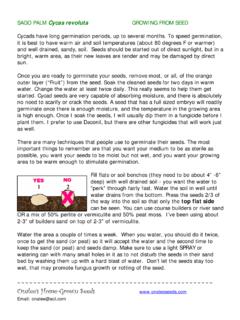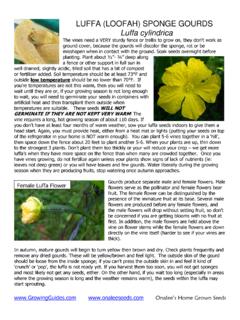Transcription of apple gourd growing and drying instructions
1 Copyright 2004 Onalee s Home Grown Seeds gourd Seedling Id apple GOURDS If you have a growing season of at least 90-100 days and plenty of space, you can be the proud owner of several hard-shelled apple gourds by fall. The vines will quickly cover a trellis, hide a chain-link fence, wrap around trees, and then keep growing ! Despite the vine's need for vast amount of space, it's a fascinating plant to grow that adults and kids love. The resulting gourds can be made into birdhouses, feeders, baskets, dishes or just paint them as an apple for the teacher! The vine requires a long hot growing season of 90 - 100 days. Since gourds demand a long growing season, they can be started indoors 4 weeks prior to planting outdoors.
2 I have successfully started gourds in regular pots with soil and transplanted them to the garden although instructions I have seen on the internet say that gourd seeds should be planted in individual containers, such as peat pots, since their roots will not like being disturbed during transplanting. You may want to try some each way to see what works for you. If you started your plants indoors, you need to start "conditioning" the plants to the great outdoors a few days before transplanting. Outdoors generally has lower humidity, less frequent rainfall and higher light levels, and if you plant your babies out directly, they may wilt. Instead, start taking them outside in the shade for a few hours a day then letting them have some direct sunlight for a couple hours a day, shade the rest.
3 Let them wilt just a tiny, tiny bit while they're outside. Give them at least 3-4 days of this sort of "abuse" before you plant them out. This is called "hardening off' and it generally results in plants that just keep right on growing without breaking stride. Once the danger of frost is past and your plants are hardened off, transplant them into tilled soil that has a bit of compost or fertilizer added. I usually plant my seeds directly in the soil on my fence line, planting about 6 seeds together in a hill (I clear a spot about 2 long and 1 wide and about 2 below grade so it will hold water, then I make a trench about 12 long in that spot and space them in there), deep, and allowing 20 of fence (10 in each direction) per hill.
4 When they have 2 or 3 of their first real leaves, thin to leave the strongest 3 vines per hill. You may also plant the vines where they can climb onto a STRONG trellis or even a tree. You may allow your vines to grow along the ground, as pumpkins do I did this last year because of all the storms and the resulting gourds looked fine. Once the gourds started forming, I put pieces of Styrofoam under them to keep them from being in contact with the ground. This kept them from staying too wet and rotting. Gourds like a soil pH around , slightly acidic. If you plant during dry months, you will need to water the vines until they are established or there is heavy rain at least weekly. Once you have vines growing , do not fertilize them again or you'll have beautiful leaves and few gourds.
5 The only pest I have had a problem with on gourds is leaf-miner. Watch for their tell-tale tunnels on your leaves and treat with appropriate insecticide or soap solution. Once the vine is about 8 to 10 feet long, pinch off the tip of the main runner so that the plant will send out side branches. It's on these side branches that the female flowers (and gourds) grow. This is very important, otherwise, you may have many flowers but few gourds. Copyright 2004 Onalee s Home Grown Seeds There are male flowers that need to pollinate the female ones. The first flowers to bloom are male and will not produce any gourds; so don t get discouraged when the first flowers fade without producing fruit.
6 Female flowers have a little bulge behind the flower that looks a bit like a little apple gourd . Male flowers only have a stem. If you have plenty of bees and insects, they will do all of the work naturally for you. Or at night when the flowers open up, take a bit of the male pollen and shake it onto the female flowers. One vine may produce up to 12 gourds, although the average is more like 5 - 6. If a gourd begins growing low on the fence and touches the ground, or if you are growing your gourds on the ground, you may want to put a small piece of Styrofoam under it to keep the moisture in the ground from rotting the gourd . The vines will love many long drinks of water throughout the summer.
7 But when autumn approaches, do not give them any supplemental waterings. Let the vines wither and die as winter approaches. Leave the gourds on the vine until a light frost or the stems turn brown. If you need to pick a gourd before the frost, the gourd should be very firm to the touch. Cut the gourd with an inch or more of stem. Wash the gourds in soapy water. Household bleach may be added to the water if desired, and may help delay mold formation. After the first frost, cut the gourds from the vines and put them in a dry warm place on a screen or hang them. It is important that air can circulate all about them, drying them. If a gourd becomes soft and begins to rot or becomes shriveled, throw it away (save the seeds!)
8 !). However, a bit of mold on the gourds is fine and normal. It may take 6 months to dry large gourds, apple gourds will take less 2-3 months. They will be ready when they are very light in weight, and you can hear the seeds inside rattle when you shake them. drying Dry the gourd fruits naturally by placing in an area with good air circulation. Bringing the gourds indoors may help them dry faster, but gourds can be dried outdoors even in cold areas, however repeated freezing and thawing will affect the viability of seeds. We have had good luck drying gourds by scraping the green outer skin off with the backside of a butter knife; this is tedious and time consuming, but produces less mold and more uniform color to the gourds.
9 Scraping is done only when the gourd is light in weight and the vine has died; if done too soon, the gourd will rot. When the seeds rattle, the gourd is dry and ready for crafting. How long it takes a gourd to dry depends on the drying environment and the size of the gourd -- the warmer and the better the circulation, the faster the water will evaporate from the gourd . Most moderate-sized hardshell gourds will be dry by Christmas. Larger or particularly thick-shelled gourds may not dry for several more months. Light may help to retard formation of mold, but the mold on the outside of gourds is a natural part of the drying process; as long as the gourd remains firm to the touch, do not discard it.
10 Turning the gourds and wiping off the mold on a daily basis may help the gourds dry sooner. Copyright 2004 Onalee s Home Grown Seeds Saving Seeds Seeds from your gourds, whether the gourds have been dried or not, can be saved for planting next year. If I harvest seeds from a still green gourd , I rinse them off (there is a slime on them in the green gourds) and place them in a warm, dry area to dry completely. I store all my seeds in breathable containers (not plastic bags). Make note, however: growing many types of gourds or squash in close proximity to each other WILL affect your seeds by creating cross-pollinated gourds. The gourds themselves will be fine, but the seeds may well produce something that does not resemble your original.













